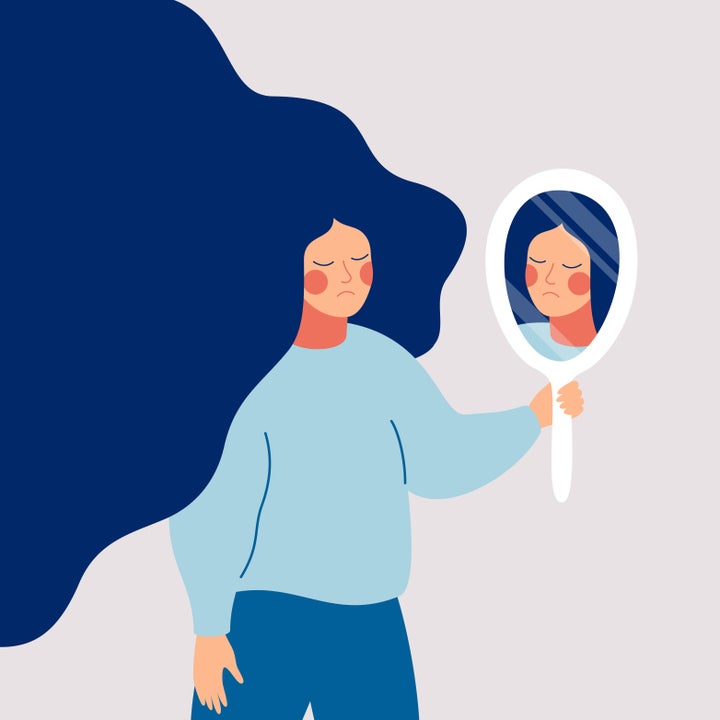
I survived child trafficking and incest abuse, but my body dysmorphia has plagued me in ways that I never anticipated during the coronavirus quarantine.
The Mayo Clinic defines body dysmorphia as a “disorder in which you can’t stop thinking about one or more perceived defects or flaws in your appearance.” In my case, it’s the result of post-traumatic stress disorder, and I’ve struggled with it for over two decades, despite years of therapy.
Only three photos exist of me between ages 10 and 20. Beginning around the time of puberty, I developed a fear of looking in mirrors and having my picture taken. I saw my abusive father’s eyes in every reflection. It frightened me so much as a 12-year-old that I learned to apply Bonne Bell lip gloss without the help of a mirror. In the years since, I have considered plastic surgery. Days before my wedding last year, I considered hiring a sketch artist instead of a photographer for the ceremony. At my worst moments, I removed all the mirrors from my walls.
Anxiety always exacerbates my dysmorphia. It melts the boundary between internal and external terror as my mind insists that I look as monstrous as I feel.
“Only three photos exist of me between ages 10 and 20. Beginning around the time of puberty, I developed a fear of looking in mirrors and having my picture taken.”
Before the pandemic, my therapist suggested anti-anxiety medication to manage those feelings and taking selfies as a form of exposure therapy. The control that I have over a selfie has helped a little, but I still experience panic attacks when someone wants to take a group photo at a work conference or family gathering. Feeling self-conscious about my anxiety amplifies the panic on a closed emotional loop. I end up fearing that I’m acting strangely because I am, in fact, acting strangely.
But group photos are not an issue during the COVID-19 crisis. Instead, video conferencing is the triggering event these days. While many people may dislike Zoom, FaceTime or other video meetings right now, I dread them. With video chat platforms as the main method of communication, I’m struggling to stay connected with my boss, friends and family while not spiraling into a full depressive meltdown. Nothing incites my body dysmorphia more than seeing my own image on screen.
Just recently I texted my boss before a video meeting, telling her that I would prefer a phone call. She texted me back, insisting that we use Zoom. The meeting itself didn’t worry me. I was over-prepared with charts, graphs and a bevy of data points. But the anxiety of knowing that I might see my own face during the meeting sent me into a panic. I took a deep breath and dug through my bag, which hadn’t left the house in eight weeks, to search for anti-anxiety medication. I swallowed the dose, knowing that I didn’t have the energy to push harder for a phone conference without divulging details of my PTSD that I absolutely did not wish to discuss with my boss. Even if I wanted to tell her that I’m a sexual abuse survivor, it would not be a brief conversation. Worse, I feared it would distract from the work that we needed to finish.
In other words, I managed the best I could.
“With video chat platforms as the main method of communication, I’m struggling to stay connected with my boss, friends and family while not spiraling into a full depressive meltdown.”
Before the meeting, I smoothed the collar of my dress shirt and straightened my favorite necklace ― a gift from a friend that holds a golden key stamped with the word ”courage.” I checked that my makeup wasn’t smudged the way that I usually do: by homing in on one specific quadrant of my face in the mirror and averting eye contact with myself.
Usually when I look at my entire reflection, I recognize only the features that remind me of my violently cruel father. The dysmorphia blinds me to everything else. That sends me into a panic attack that I can best describe as a sort of migraine. This, in part, is the reason that I have only one mirror in the entire house. It hangs above the bathroom sink and I avoid it whenever possible.
Throwing open my laptop, I logged in to the meeting and held my breath, waiting for my webcam’s green light to glow. I exhaled a sigh of relief when the screen opened to my boss’s face, not mine. We checked in about the goals for the week and I avoided glancing at the smaller screen of my image. There is a way to close the smaller window, but I couldn’t find the button. I just hoped that I didn’t look as nervous as I feel.
My boss told me that she needed to show me something and my face flashed on screen. I jumped. My dog jumped too. Recoiling, all I could see were the eyes of the person who hurt me as a child, the mouth of my father who smiled sadistically when I was in pain, and the arms of the man who hit me until my body was covered in bloody welts. I wanted to run away and I started to feel sick, but I fought the urge and reminded myself that I needed to remain composed and look professional. While my boss was having a seemingly normal meeting with her employee, I was feeling triggered.
Later that day, my nephew texted my husband and me. He wanted to FaceTime to show us his new baseball. I would have preferred a phone call, but he is obsessed with baseball and I wanted to be supportive. My husband noticed my anxiety escalating as the FaceTime call rang. He reached out to hold my hand. My breath grew more and more shallow. I tugged at my hair. I checked my phone and massaged my hands to distract myself. The video call was unable to connect for some reason and I exhaled a sigh of relief. My husband pulled me close, telling me not to worry, that I’m beautiful.
“I want people to understand that for some of us, the struggle isn’t so obvious. Check on your loved ones, even those who seem to be OK.”
It is the twisted fate of nature that even survivors of child abuse and incest must grow up to look more and more like their biological parents. When I feel calm and relaxed, I recognize my features as my own. When I feel happy, I don’t think I look grotesque like my father, who trafficked and raped me. When I’m stressed out, the symptoms of dysmorphia are much worse. As COVID-19 infections spread, it’s been hard to find ways to replace my normal coping routines while practicing social distancing.
I knew that I needed to figure out a better way to deal with this because it was interfering with my work and family and making me feel mentally unwell, so I was relieved when my therapist agreed to a phone call instead of a video conference. Within a few minutes, I asked her again if she thought that plastic surgery would help my dysmorphia.
“No, I don’t think that will address the root of what’s going on.” She pointed out that dysmorphic disorder is more psychological than physical. She told me that even if I look like my parents, I am not them. I said that I don’t want to look prettier; I just want to look different. We went around in circles like this until she finally asked me what I would change, if given the choice.
“I don’t know. A bigger nose?” I laughed. “I just want to not look like my dad.”
Hearing myself laying out this disoriented logic reminded me again that my therapist is right. Surgically changing my features won’t address the underlying reasons that I hyperventilate at the sight of my own face. Plus, plastic surgery is expensive. She assigned me homework to read Dr. Judith Herman Lewis’ book ”Trauma and Recovery” and we scheduled our next appointment.
I know what I need to do to manage my dysmorphia right now. I need to follow a regular sleep schedule, to exercise somehow and to take my anxiety medication each morning while continuing to see my therapist. Listing the steps makes them sound so easy. My prescription bottle is stamped with a label that reads “Take as needed.” But lately, “as needed” just means every day. And while I may not be able to go to the gym, I can at least remind myself to breathe.
I want people to understand that for some of us, the struggle isn’t so obvious. Check on your loved ones, even those who seem to be OK. More than anything, I want to set a good example for my niece and nephew. I’m not my father, and I want to continue to manage my mental illness so I can model healthy relationships for the kids in my family.
Have a compelling first-person story or experience you want to share? Send your story description to pitch@huffpost.com.
- Stay up to date with our live blog as we cover the COVID-19 pandemic
- What happens if we end social distancing too soon?
- What you need to know about face masks right now
- Will there be a second stimulus check?
- Lost your job due to coronavirus? Here’s what you need to know.
- Why it takes so long to make a coronavirus vaccine
- Parenting during the coronavirus crisis?
- The HuffPost guide to working from home
- What coronavirus questions are on your mind right now? We want to help you find answers.
- Everyone deserves accurate information about COVID-19. Support journalism without a paywall — and keep it free for everyone — by becoming a HuffPost member today.
